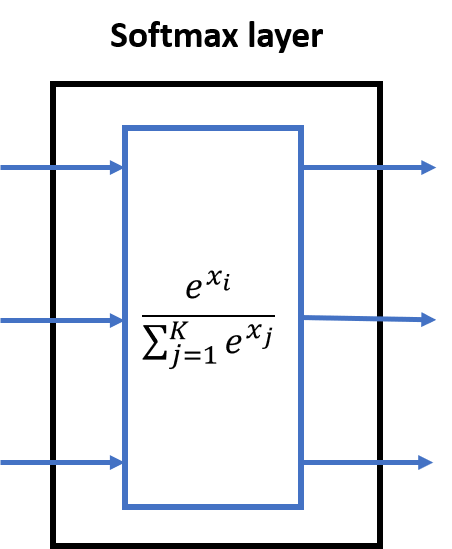 |
AIfES 2
2.0.0
|
 |
AIfES 2
2.0.0
|
Base layer implementation of the Softmax activation layer. More...
Go to the source code of this file.
Data Structures | |
| struct | ailayer_softmax |
| General Softmax layer struct. More... | |
Typedefs | |
| typedef struct ailayer_softmax | ailayer_softmax_t |
Functions | |
| ailayer_t * | ailayer_softmax (ailayer_softmax_t *layer, ailayer_t *input_layer) |
| Initialize and connect the given Softmax layer. More... | |
| void | ailayer_softmax_forward (ailayer_t *self) |
| Calculate the forward pass for given Softmax layer. More... | |
| void | ailayer_softmax_calc_result_shape (ailayer_t *self) |
| Calculate the shape of the result tensor. More... | |
| void | ailayer_softmax_print_specs (const ailayer_t *self) |
| Print the layer specification. More... | |
Variables | |
| const aicore_layertype_t * | ailayer_softmax_type |
| Softmax layer type. More... | |
Base layer implementation of the Softmax activation layer.
This is an "abstract" data-type independent implementation. To use the layer use one of the provided implementations for a specific hardware and data-type (for example from ailayer_softmax_default.h) or set the required math functions on your own.
This layer is designed as an output-layer and has no backward implementation. If you want to train an ANN with this layer, use the Cross-Entropy loss which has a combined Softmax-Cross-Entropy backward function that is faster to compute!

The Softmax layer is used as an activation function layer right after a dense layer. It calculates
\[ y_i = \frac{e^{x_i}}{\sum_{j=1}^{K} e^{x_j}} \]
for every element of the input tensor with \( K \) elements.
The results of the forward pass of this layer are written to the result tensor of the base ailayer_t struct.
| ailayer_t* ailayer_softmax | ( | ailayer_softmax_t * | layer, |
| ailayer_t * | input_layer | ||
| ) |
Initialize and connect the given Softmax layer.
This function represents the "constructor" of the abstract Softmax layer. It initializes the layer structure and connects it to the previous layer.
This function is not intended to call it directly. Instead use one of the data type specific implementations (like for example ailayer_softmax_f32_default()).
| *layer | The layer to initialize. |
| *input_layer | The previous layer that provides the inputs to the layer. |
| void ailayer_softmax_calc_result_shape | ( | ailayer_t * | self | ) |
Calculate the shape of the result tensor.
Implementation of ailayer.calc_result_shape.
As the result tensor shape is shared with the result tensor shape of the previous layer (no change in shape is needed), this function returns without doing anything.
| *self | Layer to calculate the resulting shape for. |
| void ailayer_softmax_forward | ( | ailayer_t * | self | ) |
Calculate the forward pass for given Softmax layer.
Implementation of ailayer.forward.
It uses the result tensor of the previous layer as input and writes the result of the forward pass to the result tensor (ailayer.result) of the given layer.
Calculation of the forward pass result:
\[ x_{out} \leftarrow Softmax(x_{in}) \]
\( x_{in} \): Result of the forward pass of the previous layer
\( x_{out} \): Result of the forward pass of this layer
Used math functions:
| *self | Layer to calculate the forward path for. |
| void ailayer_softmax_print_specs | ( | const ailayer_t * | self | ) |
Print the layer specification.
| *self | The layer to print the specification for |
|
extern |
Softmax layer type.
Defines the type of the layer (for example for type checks and debug prints). See aicore_layertype for more information about the layer type.